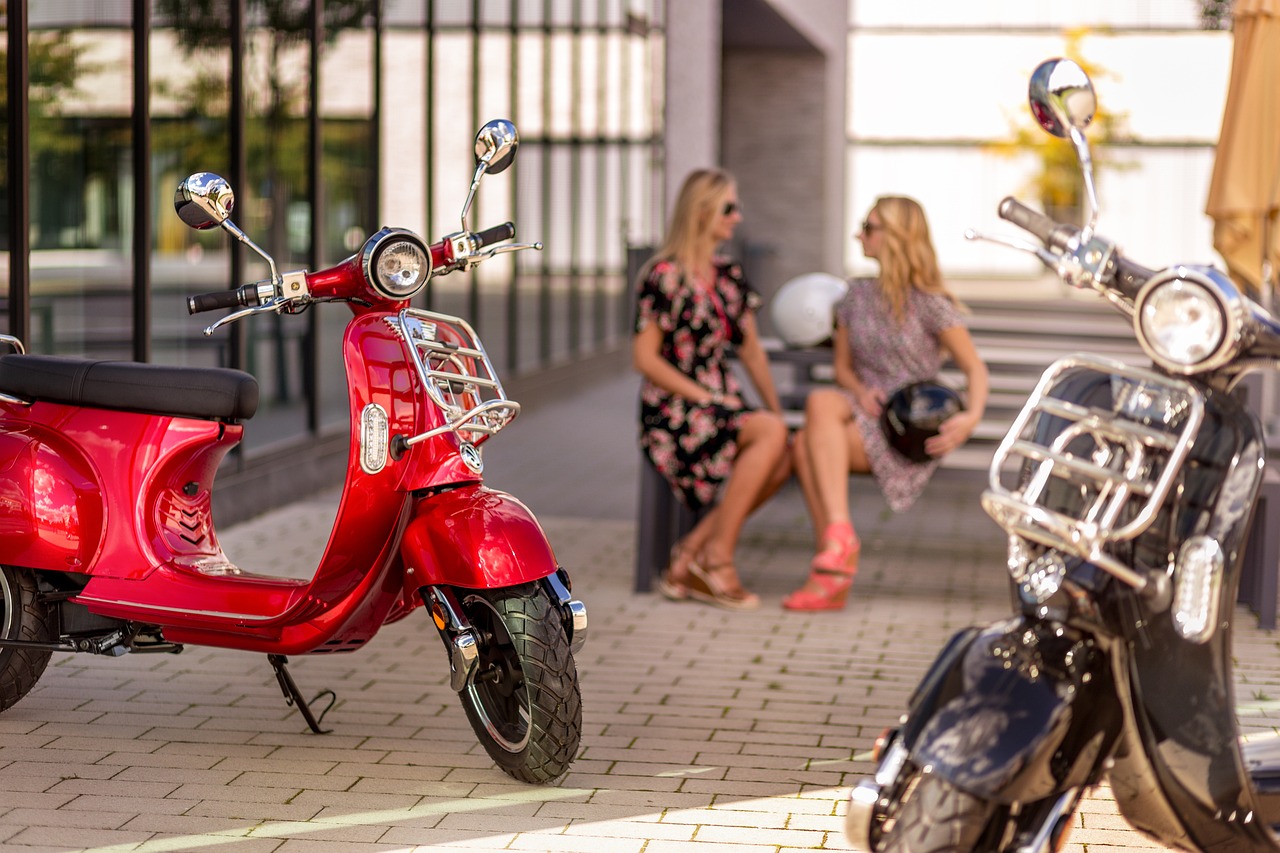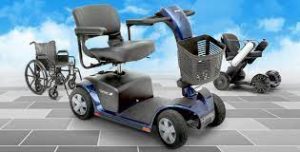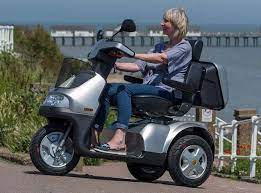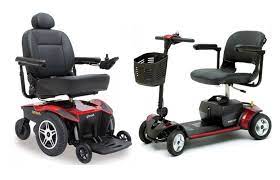Mobility Scooters Used For Sale : 5 Top Deals

In the market for a Mobility Scooters Used For Sale ? Considering a used option? You’re in the right place. This article explores the world of used mobility scooters, offering insights into their benefits, considerations, and essential factors to keep in mind. Whether you’re seeking affordability, flexibility, or accessibility, understanding the ins and outs of purchasing a pre-owned mobility scooter can empower you to make a confident and informed decision. Let’s dive in
Introduction to Mobility Scooters:

Mobility scooters are electrically-powered vehicles designed to assist individuals with mobility impairments in getting around independently. They provide a convenient and efficient means of transportation for people who may have difficulty walking long distances or standing for extended periods.
These scooters typically feature a comfortable seat, handlebars or a tiller for steering, and a set of wheels. They come in various sizes and configurations to accommodate different needs and preferences. Some models are designed for indoor use, while others are built for outdoor terrain, including rough surfaces and inclines.
One of the primary benefits of mobility scooters is their ability to enhance mobility and independence for individuals with disabilities or mobility limitations. They allow users to navigate their surroundings with ease, whether it’s running errands, visiting friends and family, or simply enjoying outdoor activities.
Moreover, mobility scooters are often more affordable and accessible than other forms of mobility assistance, such as powered wheelchairs or adapted vehicles. They require minimal physical effort to operate and can be easily transported in a vehicle or stored when not in use.
However, it’s essential to recognize that mobility scooters may not be suitable for everyone. Factors such as individual mobility needs, physical limitations, and lifestyle preferences should be carefully considered when determining whether a scooter is the right choice.
Understanding Mobility Scooters Used For Sale : Benefits and Considerations
When considering purchasing a mobility scooter, opting for a used model can offer several advantages. Understanding these benefits and considerations is crucial for making an informed decision:
- Affordability: One of the most significant advantages of buying a used mobility scooter is cost savings. Compared to brand new models, used scooters are often available at a fraction of the price, making them a more budget-friendly option for individuals on a tight budget or those looking to save money.
- Accessibility: Used mobility scooters can provide greater accessibility to individuals who may not be able to afford a new scooter at full price. This affordability factor opens up opportunities for more people to access mobility aids that can significantly improve their quality of life and independence.
- Wider Selection: The used market offers a broader selection of mobility scooter models, brands, and features compared to purchasing new. This variety allows buyers to find a scooter that meets their specific needs and preferences without being limited to the latest models available from manufacturers.
- Tested Performance: Unlike brand new scooters, which may lack real-world testing and user feedback, used scooters have a track record of performance and reliability. Buyers can research the model’s reputation, read reviews, and even test-drive the scooter before making a purchase, providing added confidence in its suitability.
- Quick Availability: While purchasing a new mobility scooter may involve waiting for availability or delivery, used scooters are often readily available for immediate purchase. This quick availability can be particularly advantageous for individuals who require a mobility aid urgently or prefer not to wait for order processing and shipping.
Despite these benefits, there are also important considerations to keep in mind when buying Mobility Scooters Used For Sale :
- Condition: Assessing the condition of a used scooter is crucial to ensure it functions properly and meets your needs. Look for signs of wear and tear, including scratches, dents, or mechanical issues. Ask the seller for maintenance records and any history of repairs or modifications.
- Warranty and Return Policies: Unlike new scooters, which typically come with manufacturer warranties and return policies, used scooters may not offer the same level of protection. Before purchasing, inquire about any warranty coverage or return options provided by the seller to safeguard your investment.
- Compatibility: Ensure that the used scooter you’re considering is compatible with your specific mobility needs and lifestyle. Consider factors such as weight capacity, battery life, terrain capabilities, and portability to ensure the scooter meets your requirements.
- Research and Comparison: Take the time to research different used scooter models, compare prices, features, and reviews from multiple sources. This comprehensive approach will help you make an informed decision and avoid potential pitfalls associated with impulse purchases.
Assessing Your Needs: Choosing the Right Mobility Scooter
Selecting the right mobility scooter involves assessing your individual needs, preferences, and lifestyle factors. Here are key considerations to help you choose the most suitable scooter:
- Mobility Requirements: Begin by evaluating your specific mobility requirements. Consider factors such as the distances you need to travel, the types of terrain you’ll encounter, and any physical limitations or mobility challenges you may have. This assessment will help determine the scooter’s necessary features and specifications.
- Indoor vs. Outdoor Use: Determine whether you primarily intend to use the scooter indoors, outdoors, or both. Indoor scooters typically have a smaller turning radius and compact design, making them maneuverable in tight spaces such as hallways and doorways. Outdoor scooters, on the other hand, are built for durability and stability on varied terrain, including sidewalks, grass, and gravel paths.
- Portability: Consider your transportation needs and whether you’ll need to transport the scooter in a vehicle or store it in limited space. Portable or travel-friendly scooters feature lightweight construction and can be easily disassembled or folded for storage and transport. Non-portable scooters may offer additional features and comfort but require more significant storage space.
- Weight Capacity: Ensure the scooter’s weight capacity accommodates your body weight and any additional items you may carry, such as groceries or personal belongings. Exceeding the weight capacity can affect the scooter’s performance and safety.
- Seating and Comfort: Comfort is essential for prolonged use of a mobility scooter. Consider the scooter’s seating options, including seat size, padding, and adjustability. Additionally, assess the scooter’s suspension system and shock absorption capabilities, especially if you’ll be traversing rough terrain or uneven surfaces.
- Battery Life and Range: Evaluate the scooter’s battery life and range to ensure it meets your daily usage requirements. Factors such as battery type, capacity, and charging time can impact the scooter’s overall performance and convenience. Choose a scooter with sufficient battery life to accommodate your typical travel distances without frequent recharging.
- Controls and Maneuverability: Test the scooter’s controls and maneuverability to ensure they are intuitive and easy to operate. Consider factors such as handlebar height, throttle responsiveness, and steering precision. If you have limited hand dexterity or strength, look for scooters with ergonomic controls and alternative steering options.
- Safety Features: Prioritize safety features such as anti-tip wheels, rearview mirrors, and lighting systems to enhance visibility and stability while operating the scooter. Additionally, consider accessories such as safety belts and flags for added security, especially when navigating busy pedestrian areas or crossing roads.
Researching Mobility Scooters Used For Sale : Where to Look and What to Look For

Researching used mobility scooters is crucial to finding a reliable and suitable option that meets your needs and budget. Here’s a guide on where to look and what to look for during your research process:
- Online Marketplaces: Start your search by browsing online marketplaces such as eBay, Craigslist, or Facebook Marketplace. These platforms offer a wide selection of used mobility scooters from private sellers and dealerships. Use search filters to narrow down options based on your preferences, including price range, location, and scooter specifications.
- Specialized Retailers: Explore specialized retailers or dealerships that specialize in selling new and used mobility aids. These establishments often have a dedicated inventory of refurbished or pre-owned scooters, along with knowledgeable staff who can assist you in finding the right model for your needs. Visit local stores or search for reputable online retailers in your area.
- Classified Ads: Check local classified ads in newspapers, community bulletin boards, or senior centers for listings of used mobility scooters for sale. Many individuals advertise their scooters for sale locally, offering the opportunity to inspect and test-drive the scooter before making a purchase.
- Online Forums and Support Groups: Join online forums, discussion boards, or social media groups dedicated to mobility scooter users. These communities are valuable resources for connecting with other scooter users, sharing experiences, and exchanging information about buying and selling used scooters. Members may also offer recommendations and insights into reputable sellers or potential pitfalls to avoid.
- Refurbished and Certified Pre-Owned Programs: Some manufacturers or retailers offer refurbished or certified pre-owned mobility scooters with warranties and quality assurance guarantees. These programs typically involve thorough inspections, repairs, and testing to ensure the scooters meet stringent quality standards. Consider exploring these options for added peace of mind and reliability.
When researching Mobility Scooters Used For Sale , pay attention to the following factors:
- Price: Compare prices across different sellers and platforms to ensure you’re getting a fair deal. Be wary of prices that seem too good to be true, as they may indicate hidden issues or scams.
- Condition: Request detailed photos and descriptions of the scooter’s condition, including any cosmetic flaws or mechanical issues. Look for signs of wear and tear, such as scratches, dents, or worn-out components. Ask the seller about the scooter’s maintenance history and any recent repairs or upgrades.
- Specifications: Review the scooter’s specifications and features to ensure they meet your mobility needs and preferences. Consider factors such as weight capacity, battery life, maximum speed, and terrain capabilities. Verify that the scooter’s dimensions and weight are compatible with your transportation and storage arrangements.
- Seller Reputation: Research the seller’s reputation and credibility before making a purchase. Check customer reviews, ratings, and feedback from previous buyers to gauge their reliability and trustworthiness. If possible, communicate directly with the seller to ask questions and address any concerns you may have.
Inspecting Mobility Scooters Used For Sale : Key Points and Red Flags
Inspecting a used mobility scooter is a critical step to ensure that it meets your expectations in terms of functionality, safety, and overall condition. Here are key points to consider and red flags to watch out for during the inspection process:
- Physical Examination:
- Frame and Structure: Carefully inspect the scooter’s frame and structure for signs of damage or wear. Look for cracks, dents, or bent components, especially around the chassis and steering column.
- Wheels and Tires: Check the condition of the wheels and tires for wear, punctures, or uneven tread. Ensure that the tires are properly inflated and securely attached to the wheels.
- Controls and Components: Test the operation of the scooter’s controls, including the throttle, brakes, and steering mechanism. Verify that all components, such as lights, horn, and indicators, are functional and responsive.
- Battery and Electrical System: Assess the condition of the scooter’s battery and electrical system. Check for signs of corrosion or damage to the battery terminals and wiring. Test the battery’s voltage and charging capacity to ensure it holds a charge and provides sufficient power.
- Seat and Upholstery: Examine the condition of the scooter’s seat and upholstery for tears, stains, or signs of wear. Ensure that the seat is securely attached to the scooter and provides adequate support and comfort.
- Accessories and Extras: Evaluate any additional accessories or extras included with the scooter, such as baskets, cup holders, or canopies. Verify their condition and functionality to determine their value and usefulness.
- Test Drive:
- Maneuverability: Take the scooter for a test drive to assess its maneuverability and handling. Test its performance on various surfaces, including smooth pavement, gravel, and slopes.
- Speed and Acceleration: Evaluate the scooter’s speed and acceleration capabilities to ensure they meet your needs and preferences. Test the scooter’s braking system to ensure it responds promptly and effectively.
- Comfort and Ergonomics: Pay attention to the scooter’s comfort and ergonomics during the test drive. Evaluate the seat’s padding and adjustability, as well as the positioning of the handlebars and controls for optimal comfort and accessibility.
- Documentation and History:
- Maintenance Records: Request any available maintenance records and documentation related to the scooter’s history. Review records of past repairs, servicing, and inspections to assess the scooter’s maintenance history and overall condition.
- Ownership History: Inquire about the scooter’s ownership history and usage patterns. Ask the seller about the scooter’s primary use, frequency of use, and any previous owners to gain insight into its past usage and care.
- Red Flags:
- Signs of Neglect: Watch out for signs of neglect or poor maintenance, such as rust, corrosion, or excessive dirt buildup. These may indicate underlying issues or a lack of proper care and upkeep.
- Mechanical Issues: Be cautious of any unusual noises, vibrations, or performance issues during the test drive. These could be indicators of underlying mechanical problems or wear and tear that may require costly repairs.
- Incomplete Documentation: Beware of sellers who are unable or unwilling to provide comprehensive documentation or history of the scooter. Lack of maintenance records or ownership history may suggest a lack of transparency or potential issues with the scooter’s condition.
Negotiating and Purchasing Mobility Scooters Used For Sale : Tips and Tricks

Negotiating and purchasing a used mobility scooter can be a straightforward process with the right approach. Here are some tips and tricks to help you navigate the negotiation and buying process effectively:
- Research Market Prices: Before entering negotiations, research the market prices for similar used mobility scooters to establish a fair and reasonable price range. Consider factors such as the scooter’s age, condition, features, and market demand when determining its value.
- Inspect the Scooter Thoroughly: Conduct a comprehensive inspection of the scooter to identify any issues or areas of concern. Use your findings to negotiate a fair price based on the scooter’s condition and any necessary repairs or maintenance.
- Highlight Positive Attributes: Emphasize any positive attributes or desirable features of the scooter during negotiations. Highlighting the scooter’s low mileage, recent upgrades, or well-maintained condition can strengthen your bargaining position and justify your offer.
- Point Out Areas for Improvement: While highlighting the scooter’s positive aspects, also identify any areas for improvement or potential issues that may warrant a lower price. Be honest and transparent about any repairs or maintenance the scooter may require, and use this information to negotiate a mutually acceptable price.
- Negotiate Based on Value: Instead of focusing solely on price, negotiate based on the overall value offered by the scooter. Consider factors such as included accessories, warranty coverage, and seller incentives when evaluating the scooter’s worth and making counteroffers.
- Be Prepared to Walk Away: If negotiations reach an impasse or the seller is unwilling to meet your desired price, be prepared to walk away from the deal. Avoid feeling pressured into making a purchase if you’re not comfortable with the terms or pricing offered.
- Secure Payment and Documentation: Once you’ve agreed on a price, ensure that payment and documentation are handled securely and legally. Consider using secure payment methods such as cash, bank transfer, or escrow services to protect against fraud or disputes. Obtain a written sales agreement or receipt detailing the terms of the sale, including any warranties or guarantees provided by the seller.
- Arrange Transportation or Delivery: If necessary, make arrangements for transporting the scooter to your desired location. Coordinate with the seller to arrange pickup or delivery options, ensuring that the scooter is safely transported and arrives in the same condition as described.
- Follow Up After Purchase: After completing the purchase, follow up with the seller to confirm receipt of payment and ensure that all necessary documentation has been provided. If any issues or concerns arise after the sale, maintain open communication with the seller to address them promptly and amicably.
Mobility Scooters Used For Sale Conclusion
In conclusion, purchasing a used mobility scooter offers a practical and affordable solution for individuals seeking greater mobility and independence.
By understanding the benefits, considerations, and steps involved in researching, inspecting, negotiating, and purchasing a used scooter, individuals can make informed decisions that meet their specific needs and preferences.
From assessing mobility requirements to evaluating scooter condition and negotiating a fair price, each step of the process contributes to a successful and satisfying buying experience.
With thorough research, careful inspection, and effective negotiation tactics, individuals can find a reliable and suitable mobility scooter that enhances their quality of life and empowers them to navigate their surroundings with confidence and ease.
Whether seeking indoor convenience or outdoor versatility, a used mobility scooter can be a valuable investment in mobility and independence for individuals of all ages and abilities.


